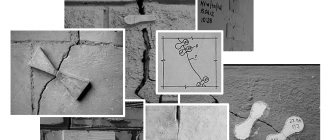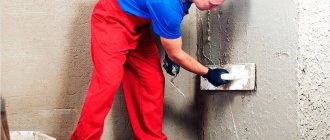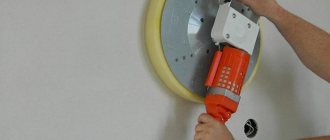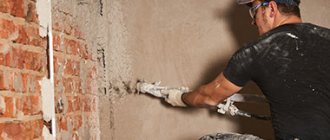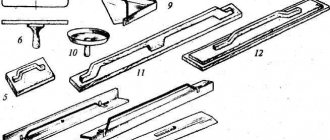Reasons for using beacons
The use of guides is carried out for the convenience of plastering and a number of other repair works. The reason is that when beacons are installed on the surface, they act on it as supporting elements, creating a flat plane vertically and horizontally.
In some situations, they are made from solution, which eliminates the need for further extraction. After some hardening, such elements are given a rectangular shape, and then they are leveled and plastered. Their disadvantage is that they take a long time to dry, and in addition, the guides made of mortar are partially erased during the process of leveling the surfaces, as a result of which irregularities and depressions form on them.
Note! In addition to them, wooden blocks were also often used as beacons in the past, but after a certain period of service they can begin to rot, being under the plaster layer.
After a while, a modern version appeared on the market - affordable perforated profiles of various lengths, made of galvanized metal, which are more preferred today. Their significant advantage is the high speed of installation, after which you can proceed without delay to further work and, as a result, give the treated surface an ideal look.
Elements made of plastic also have disadvantages, being excessively flexible and soft. For this reason, during the application of plaster or other mixture, even with a slight impact through the rule, a change in their shape can occur. As a result, it is not possible to achieve a perfectly flat plane of the treated surfaces. Taking this into account, metal beacons are the most suitable solution for such problems.
Note! Before purchasing beacons, you need to decide on the thickness of the future coating being formed, since the selected guides will impose certain restrictions on this indicator.
Why are beacons under plaster needed?
With the help of beacons, a contour is created for applying plaster, which serves to subsequently align the geometry of the walls. The correct installation of the beacons determines how smooth the walls will be after plastering. This is the most important stage of rough wall finishing.
Beacons are of the following types:
- Metal;
- Plastic;
- Reusable steel;
- Strings;
- By brand.
We will tell you in more detail about the advantages and disadvantages of each type of beacon.
Galvanized and aluminum beacons
Metal beacons can be called the most popular products. They are such due to their low price and popularity: such beacons can be found in any hardware store. These products have fairly simple instructions for use, which makes them popular for DIY repairs. Metal beacons have standard sizes of 6 and 10 millimeters. The choice of one of these options depends on the required amount of solution and deviations in the geometry of the room.
Metal beacons also have a number of disadvantages. For example, they should be carefully checked when purchasing for defects - the products may turn out to be crooked. You also need to make sure that they do not bend during transportation. When attaching such beacons to a wall, it is imperative to provide them with a rigid base.
Plastic beacons
Products made of high-strength plastic are lightweight, which makes them easy to install and remove. In terms of strength, plastic beacons are not inferior to the classic metal version, with the difference that when deformed, the plastic retains its original geometry. This fact allows them to be stored for a long time. Plastic beacons can be safely left under a layer of plaster without being removed, as they are not subject to rust.
Among the disadvantages of plastic beacons, it is worth noting their relatively high cost and unsuitability for external decoration in our climate (plastic becomes brittle in severe frost) and lack of resistance to strong impacts. In addition, plastic beacons can bend under the rule if they are not provided with a sufficiently strong base.
Reusable steel beacons
These products are the most durable among the entire range of beacons for plaster. These reusable devices are most often used by professionals due to their high cost and payback only on an industrial scale.
Why do you need to remove beacons?
Most professional craftsmen with many years of experience claim that there are several reasons for which it is necessary to remove metal profiles after the final hardening of the plaster mixture.
The occurrence of corrosion
The appearance of rust on the finishing material is the main reason why beacons have to be removed after plastering the walls. The occurrence of such a defect occurs when using profiles made of metal, even if they are galvanized. During work, these elements may be accidentally damaged when excessive load is applied to the products themselves, which leads to abrasion of their protective layer. As a result, such exposure causes the part of the guides that is prone to rust to be cleaned.
In addition, corrosion can form due to the poor quality of the beacons themselves. Often this happens due to the presence of counterfeit products on the market, which are sometimes sold by sellers who do not even know about it. In such a situation, the guides are manufactured under a well-known brand, but from raw materials of an order of magnitude lower quality. As a result, when carrying out repair work on the walls, such low-grade beacons are often fixed, the dismantling of which is not carried out after plastering, as a result of which some time later they begin to rust under a layer of the mixture.
The third cause of corrosion can be caused by too high a level of moisture present in the room. In well-heated and ventilated rooms, the likelihood of its formation is extremely low. If in rooms, which include the kitchen, bathroom and other similar ones, due to the presence of increased dampness, the appearance of rust on metal beacons is much higher.
Formation of cracks
Beacons are often dismantled precisely for this reason, since many people, including professionals, claim that such damage occurs if they are not removed after plastering the wall. There is no generally accepted opinion on this matter, because some craftsmen indicate that cracks form due to mechanical impact on the guides, for example, if you touch one of them when making a hole for a fastener. Other experts believe that damage occurs when beacons are removed from surfaces.
Cracks can also occur if the stage is excluded, during which, before installing the guides, the walls are opened with a primer in the places of their future placement. It is also important to install the elements on flat surfaces without internal or external damage. If they are not eliminated first, then cracks are guaranteed.
Note! If the distance between the elements is made greater than what is recommended, then some time after installation they will begin to move away, leading to the formation of cracks and breaks.
The main reason why this can happen is due to frequent vibration of the walls and shrinkage of the plaster mixture.
When to remove beacons
You can leave plastic guides under the wallpaper on the walls of a bedroom or children's room. It is not necessary to remove elements if the moisture level in the room reaches 45-60%. Removal of metal beacons must be done where there is a significant likelihood of corrosion and damage.
Regardless of the material used, the guides should be removed until the plaster becomes strong. The reason is that it is much more difficult to remove elements from the frozen mixture. If you do not wait for the composition to partially acquire strength, then when removing metal or plastic products, it will significantly fall off.
How to remove beacons after plastering walls
After determining whether the beacons need to be removed after plastering, you must also become familiar with the process itself, which remains to be done. To remove these elements, you need pliers and a tool with which to pry them off. In many cases, a plaster scraper or a dull chisel is used as a second one.
The work itself must be carried out as follows:
- Initially, you need to determine the place where the beacons hidden under the plaster are located. If metal guides were used during the plastering process, then you can use a magnet to find them.
Note! For greater convenience, before applying the solution, you can make corresponding small marks on the ceiling or draw the elements on a sheet of paper indicating the exact coordinates. In this way, you can mark the location of not only metal beacons, but also those made of wood or plastic.
- Next, you need to take a stepladder or a strong chair and place it against the wall from which you will be removing the guides, since they are installed from the ceiling itself.
- At the next stage, using a scraper or other similar tool, you need to remove a small amount of the plaster coating in the upper part of the surface where the product is located, and then pry it off. There is no need to worry too much about minor crumbling of the gypsum plaster.
- After partially freeing the beacon from the solution using pliers, you need to grab this place and slowly begin to separate it from the surface. The process itself should look like twisting or winding, performing the appropriate movement.
Important! You should not pull out the guides entirely from the walls at once. It is best to dismantle them in parts, which will reduce the amount of further plastering work.
- Next, you need to continue removing the elements using pliers in pieces 15-20 cm long, gradually moving down towards the floor.
Removing beacons from cement plaster is done in almost the same way. In some cases, surfaces treated with them can be slightly more difficult to interact with, but as a result, the work can be done with your own hands. It only takes a few minutes to remove one item.
Regardless of what plaster mixture the wall was previously treated with, the places where the beacons were located should, after removal, be treated with a similar composition based on gypsum or cement to eliminate the recesses left from them. The work must be carried out in the same way as with the usual application of the solution.
How to dismantle beacons
Beacons must be removed in such a way that this procedure damages the coating as little as possible.
Immediately after finishing the plastering, you need to make cuts along both side edges of the beacons using a spatula and remove the mortar between them with a screwdriver - this will reduce the connection of the profile with the plaster layer and make dismantling easier. The ends of the beacons must also be cleaned of plaster.
The next day, a screwdriver is driven into the end of the lighthouse and bent away from the base. The tip of the profile is clamped across the axis with pliers, rotating which the beacon is wound around the jaws of the tool. Sometimes it is enough to simply pull the end of the profile away from the wall, and it will separate from the mortar on which it was sitting.
The furrow remaining after dismantling is filled with plaster mortar and rubbed.
Is it possible to leave beacons in plaster?
In certain situations, the guides may remain. They do not need to be removed if tiles are subsequently laid on the walls or if natural or artificial stone, lining, plasterboard sheets, plastic or wood panels are installed.
If there is no desire to remove elements after plastering, then when carrying out the work it is necessary to adhere to the technology and related rules, as well as pre-select high-quality products, giving preference to products from a manufacturer that has proven itself in the market.
After figuring out when to remove the beacons after plastering the walls, you will be able to avoid a number of shortcomings in the future, the likelihood of which is extremely high when they are left under the mortar, which should be taken into account before carrying out further work.
Video:
In what cases should you not pull out beacons?
According to experts, it is not always necessary to dismantle plaster beacons.
It is not recommended to remove elements from the layer if decorative stone or ceramic tiles were used to decorate the walls.
If the master is going to leave the beacons inside the plaster layer, you should first protect their surface from oxidation. When the plastering work is completed, the working surface of the elements is coated with a special anti-corrosion compound. It is worth noting that the effect of this procedure is not always clear. The result directly depends on the quality of the coloring composition and on the characteristics of the cement mortar. The coating will wear out over time - it should be renewed, but if the beacons are left in the thickness of the plaster, this will not be possible.



